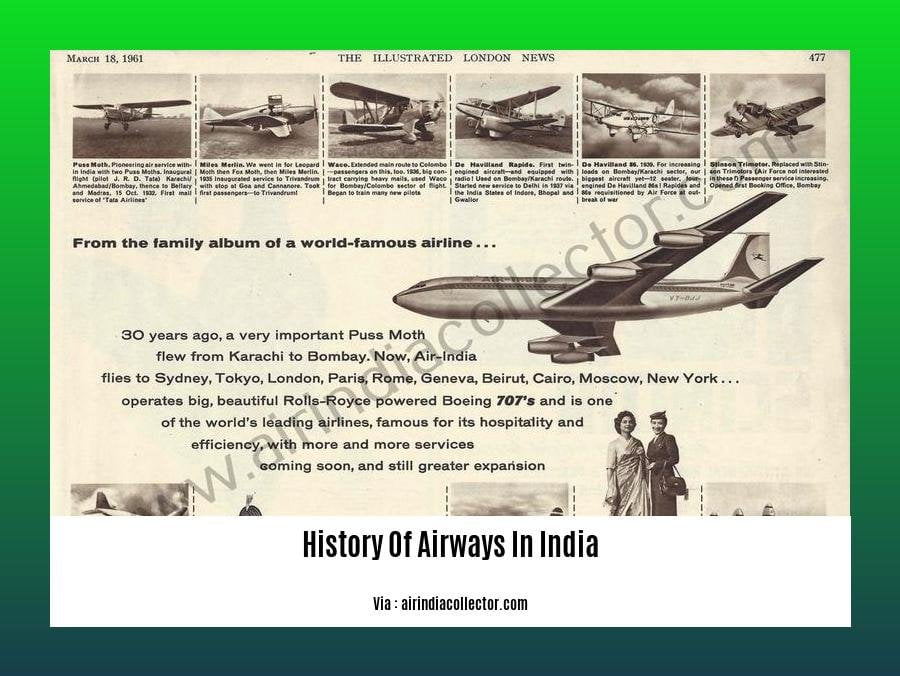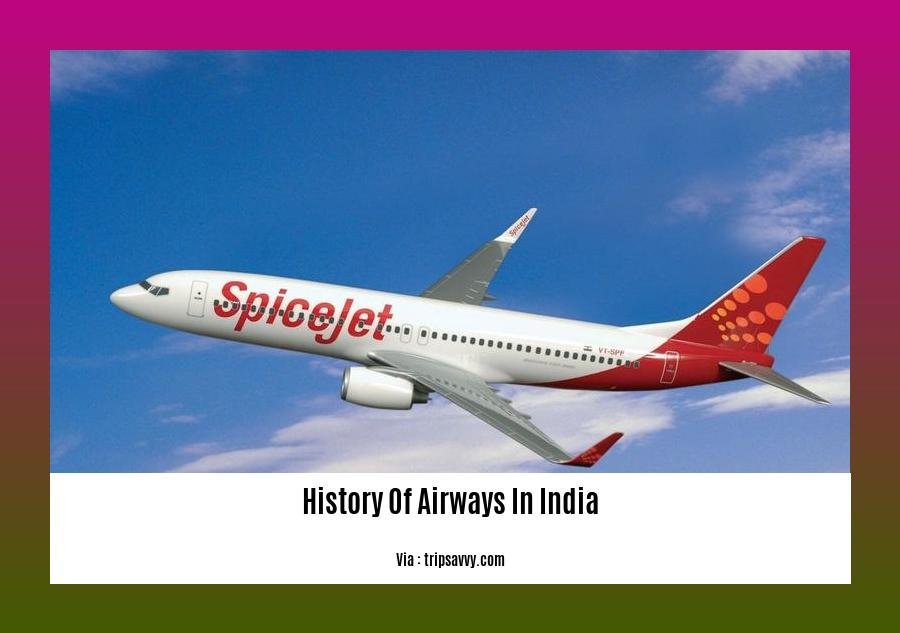Fasten your seatbelts and prepare for an exhilarating journey through the uncharted skies of Indian aviation history as we unveil the chronicles of Airways in India. Our odyssey begins at the dawn of commercial aviation in India, where pioneering aviators dared to conquer the vast expanse above. Get ready to be captivated by the tales of triumph and adversity, innovation and regulation, as we trace the evolution of Indian airways, from its humble origins to its current position as a global aviation powerhouse. Join us as we navigate the skies, exploring the rich history and legacy of Indian aviation.
Key Takeaways:
The nascent aviation era in India commenced in 1911 with air mail operations between Allahabad and Naini.
Leading up to India’s independence, the nation’s aviation landscape was shaped by foreign players like British, French, and Dutch entities.
Indian National Airways, established in 1933, marked the inception of indigenous aviation endeavors.
Post-independence, India witnessed a surge in aviation companies, reshaping the sector.
Indian Airlines’ inception in 1953 marked a strategic move by the government to consolidate the fragmented aviation market, fostering competition and growth.
The early 90s presented significant challenges to Indian Airlines as it encountered increasing competition.
In 2007, a merger between Air India and Indian Airlines solidified unity within the industry.
History of Airways in India

A Century-Old Legacy: Tracing the Roots of Indian Aviation
Since the humble beginnings of air mail operations between Allahabad and Naini in 1911, the history of airways in India is a captivating tale of pioneering spirit, technological advancements, and the indomitable will to connect people and places. In this journey through the skies, we’ll explore the milestones, challenges, and triumphs that have shaped the aviation landscape of our nation.
The Early Years: A Tapestry of Partnerships and Innovations
In the 1920s, India witnessed the arrival of foreign aviation companies like British, French, and Dutch, who laid the foundation for commercial flights. These partnerships brought international expertise and paved the way for the establishment of the first domestic airline, Indian National Airways, in 1933.
Post-Independence Era: Consolidation and Growth
With India’s independence in 1947, the aviation sector underwent a metamorphosis. The government recognized the need for a unified and robust air transport system, leading to the creation of Indian Airlines in 1953. This move consolidated the fragmented aviation market and set the stage for the industry’s growth and expansion.
The Winds of Change: Competition and Globalization
The early 1990s ushered in an era of competition for Indian Airlines, as private carriers entered the market, bringing fresh ideas and a customer-centric approach. Globalization further fueled the demand for air travel, necessitating the modernization of infrastructure and the adoption of international standards.
Merger and Consolidation: A Strategic Alliance
In 2007, Air India and Indian Airlines merged to form a formidable entity, leveraging their combined strengths and resources. This strategic move aimed to enhance competitiveness, optimize operations, and position the merged entity as a global aviation player.
The Road Ahead: Embracing Technology and Sustainability
As we look to the future, the aviation industry in India stands poised for further growth and transformation. Technological advancements, such as artificial intelligence and data analytics, hold immense potential to enhance efficiency, safety, and passenger experience. Additionally, the focus on sustainability is driving the adoption of eco-friendly practices and the exploration of alternative fuels, ensuring a greener and more responsible aviation ecosystem.
The history of airways in India is a testament to the vision, innovation, and resilience of those who dared to take to the skies. From humble beginnings to becoming a global aviation powerhouse, the journey has been marked by challenges and triumphs, shaping the nation’s connectivity and economic growth. As we continue to soar higher, the future promises even greater heights for Indian aviation.
Want to know about the Alaskan Malamutes’ ancient lineage? Dive into the history of Alaskan Malamute and uncover the fascinating tale of these majestic sled dogs.
Learn about the brief history of India and explore the rich tapestry of a civilization that has shaped the world for millennia.
History Of Airways In India Pdf

Air travel has become an integral part of modern life, connecting people and businesses across vast distances. But how did this incredible journey begin in India? Let’s delve into the rich history of airways in India, a tale marked by innovation, challenges, and remarkable growth.
The Wright Brothers’ Legacy Takes Flight in India
The pioneering spirit of the Wright brothers soared across continents, inspiring Indian aviators to take to the skies. In 1910, the first-ever flight in India took place in Allahabad, marking the dawn of a new era in transportation.
Tata Airlines: A Trailblazing Venture
In 1932, J.R.D. Tata, a visionary industrialist, founded Tata Airlines, Asia’s first commercial airline. This pioneering venture connected Karachi, Mumbai, and Madras, laying the foundation for a connected India.
Post-Independence: A New Era of Aviation
With India’s independence in 1947, the aviation industry underwent significant changes. Tata Airlines was renamed Air India, and the government acquired a stake in the company, fostering its growth and expansion.
Deregulation and the Rise of Private Airlines
The 1990s witnessed a pivotal shift in the Indian aviation landscape with the deregulation of the industry. Private airlines, such as Jet Airways and Air Sahara, emerged, introducing competition and transforming the market.
The Low-Cost Revolution: Making Air Travel Accessible
The 2000s ushered in a new era of affordability and accessibility with the advent of low-cost carriers like IndiGo and SpiceJet. These airlines democratized air travel, making it accessible to a broader segment of the population.
Consolidation and the Emergence of Major Players
In recent years, the Indian aviation industry has witnessed consolidation, with major players like Air India and IndiGo dominating the market. These airlines have expanded their fleets, routes, and services, catering to the growing demand for air travel.
Key Takeaways:
- The history of airways in India is a chronicle of innovation, marked by pioneering ventures like Tata Airlines and the subsequent rise of private airlines.
- Deregulation and the emergence of low-cost carriers revolutionized the industry, making air travel accessible to a wider segment of the population.
- Today, the Indian aviation sector is a vibrant mix of government-run and private airlines, with Air India and IndiGo leading the market.
Citations:
- History of Indian Aviation
- Timeline of Indian Aviation
History of the Airline Industry in India
Since the humble beginnings of air travel in India, airlines have played a crucial role in the country’s connectivity and economic growth. Here’s a journey through the skies that chronicles their evolution and impact:
The Dawn of Indian Aviation:
- Pioneer in Flight:
India’s aviation history took flight in 1911 with the first air mail service between Allahabad and Naini. - Tata’s Soaring Vision:
J. R. D. Tata, with his visionary spirit, founded Tata Airlines – Asia’s first commercial airline – in 1932, opening new chapters in connectivity.
A New Era of National Carriers:
- Public-Private Partnership:
Post-independence, a joint venture between Tata Airlines and the government led to the formation of Air India, solidifying its status as a national carrier. - Indian Airlines Takes Wing:
To strengthen domestic connectivity, Indian Airlines was established in 1953, becoming a pivotal player in India’s aviation framework.
A Competitive Sky:
- Open Skies Policy:
In 1994, India took a bold step toward liberalization by deregulating the aviation industry, ushering in an era of private airlines and heightened competition. - Private Players Soar High:
The deregulation paved the way for Jet Airways and IndiGo, among others, to take to the skies, challenging the dominance of public carriers.
Growth and Consolidation:
- Aviation Boom:
The 2000s marked a period of rapid growth for Indian aviation, fueled by economic expansion and increased demand for air travel. - The Low-Cost Revolution:
Low-cost carriers like IndiGo and SpiceJet took advantage of the growing market, democratizing air travel and enabling broader access to the skies. - A Market Poised for Takeoff:
Today, India’s aviation industry is soaring high as one of the fastest-growing markets globally. The future promises even greater heights, with India expected to become the world’s third-largest aviation market by 2025.
Key Takeaways:
- India’s aviation journey took off in 1911 with the initiation of an air mail service between Allahabad and Naini.
- J.R.D. Tata’s vision led to the establishment of Tata Airlines, pioneering commercial aviation in Asia.
- A joint venture with the government resulted in the creation of Air India, solidifying its position as a national carrier.
- Indian Airlines was formed to strengthen domestic connectivity, playing a vital role in India’s aviation framework.
- Deregulation in 1994 opened the skies to private airlines, introducing competition and transforming the industry landscape.
- The aviation boom of the 2000s fueled rapid growth, boosted by economic expansion and increased demand for air travel.
- Low-cost carriers democratized air travel, making it accessible to a broader audience and expanding the reach of aviation in India.
- Today, India’s aviation industry stands tall as one of the fastest-growing markets globally, poised for even greater heights in the future.
Sources:
- The History of Indian Aviation
- Indian Aviation Industry Outlook
FAQ
Q1: When did aviation first take flight in India?
A1: The history of aviation in India dates back to 1911, when air mail operations began between Allahabad and Naini.
Q2: Who were the pioneers of aviation in India?
A2: J.R.D. Tata played a crucial role in the development of Indian aviation. He founded Tata Air Services in 1932, which eventually became Air India.
Q3: What was the impact of deregulation on the Indian aviation industry?
A3: The deregulation of the aviation industry in 1994 led to the entry of private airlines, such as Jet Airways and IndiGo, which brought competition and transformed the market.
Q4: What factors contributed to the aviation boom in India?
A4: Economic growth, increasing disposable incomes, and the growing middle class in India fueled the aviation boom in the 2000s.
Q5: What is the current status of the Indian aviation industry?
A5: The Indian aviation industry is currently experiencing growth and is expected to become the world’s third-largest aviation market by 2025.
- Unlock Elemental 2 Secrets: Actionable Insights Now - April 2, 2025
- Lot’s Wife’s Name: Unveiling the Mystery of Sodom’s Fall - April 2, 2025
- Photocell Sensors: A Complete Guide for Selection and Implementation - April 2, 2025
















